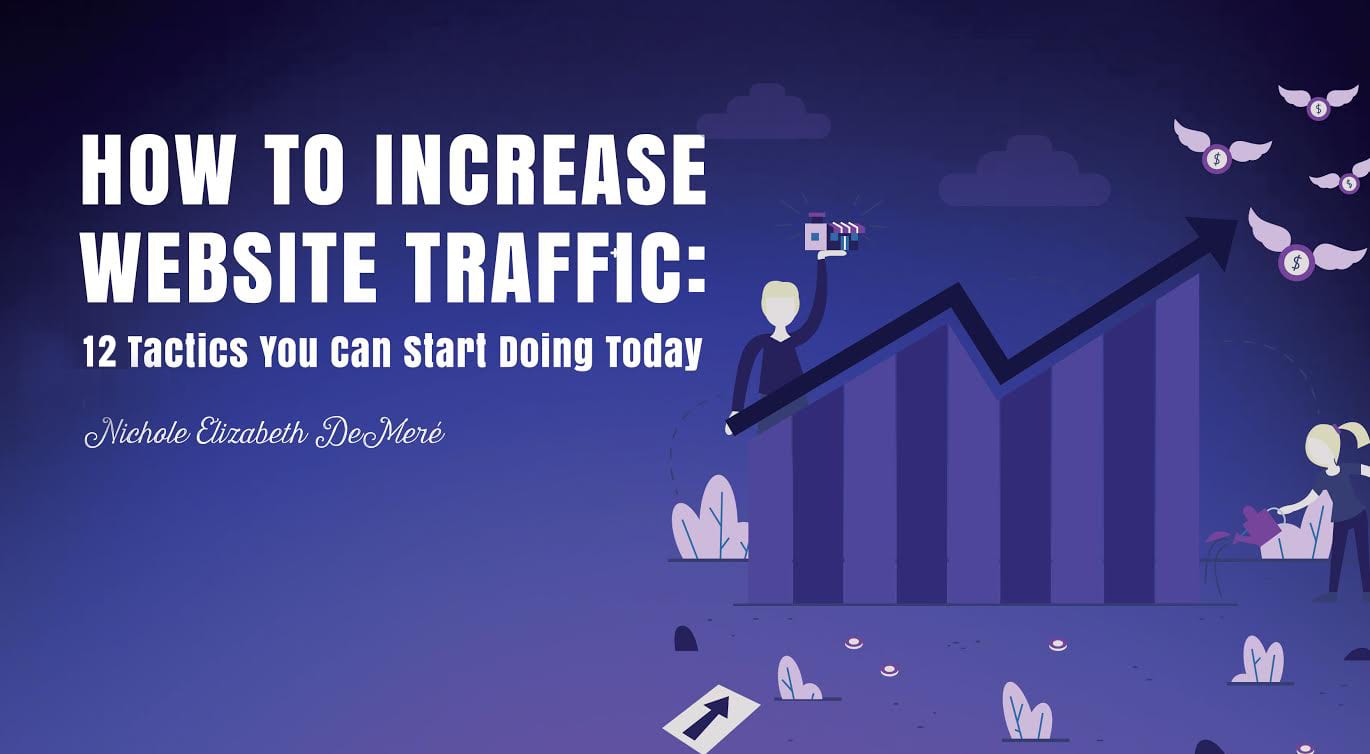
In this guide, we’ll be covering all the ways to increase website traffic—it’s not just about SEO and SERP rankings!
This crash-course includes inbound marketing, blogging, influencer marketing, native advertising, paid ads and more, complete with ‘quick wins’ and long-term foundations for high-quality traffic growth.
Anyone can boost website traffic.
You can hire a company on the other side of the world to inflate your numbers in a day. But that’s not what you want.
You want to attract people who are likely to become customers. You want to bring in your target audience.
When you fine-tune your holistic marketing strategy and brand presence to speak directly to your target audience, you’ll see exponentially higher traffic as a few things come into play:
- If you’ve done your job right, you will find your target audience genuinely needs the content you’ve written, they will spend time reading that content, explore your site further, and share the insights that they find most useful.
- The factors in the paragraph above are the engagement metrics that Google uses to rank your website on search engine results pages (SERPs). The longer people spend on your site reading your articles, and the more they share them and link to them, the higher your website will climb on SERPs, and the more traffic you’ll get.
- When your content is consistent and the best resource on the web for your niche, you gain a reputation as the ‘go-to’ trusted source. That’s what builds brand names and customer bases.
Increasing website traffic comes down to two things: creating relevant, extremely helpful content and getting it in front of the right people. You do this via inbound content marketing and paid advertisements.
We’ll break down what you can do today, and in the long-run, for the highest-impact use of your marketing budget to increase website traffic.
What is inbound marketing?

Inbound marketing is any technique or strategy that draws customers to your website. This could be in the form of content such as blog posts, articles and ebooks or via social media marketing, SEO, and branding.
Outbound marketing is more traditional, think direct mail ads, telemarketing, email marketing and attending industry events. Outbound marketing typically broadcasts to as wide an audience as possible. Inbound marketing is for a specific, target audience of ideal customers, it’s not trying to attract everybody. That’s why it works so well.
Inbound marketing also strengthens your SERP ranking. It can position you as a ‘thought-leader’ in your industry and it can promote brand awareness that leads to more traffic and higher conversions.
Website content and blogging.
It’s now not enough to produce really good content that is informative, actionable, and original. In the past, searchers would find your content from keywords; and, if you produced enough of it regularly, your SERP ranking would rise.
That search algorithm has changed a lot in the past decade. Keywords are still useful, but you need a whole lot more to climb to the top of the SERP mountain. Today, high quality content alone will give you parity with your competitors. To beat them, you need strategy.
Moz has conducted a series of studies over the last two years to find out which metrics correlate most to page rankings, and it’s these:
- Traffic
- Time spent on site by visitors
- Pageviews
- Bounce rate
Your content strategy needs to aim at maximizing those metrics.
A quick word about SEO.

There’s on-page SEO, which includes things like choosing relevant keywords with optimal search volume. And there’s off-page SEO, which means techniques used to improve SERP rankings that take place outside of your website. We discuss both.
On-page SEO
Each post title should contain your target keyword or long-tail keyword phrase, right at the beginning. That post title should also be included in your blog post’s URL.
How do you choose the right keywords? There are many ways and many tools to help you. Google Analytics is a good bet, but if you’re new to the whole SEO thing, I find Moz’s Keyword Explorer more user-friendly. Eventually though, you’ll need to figure out Google Analytics, so you might as well start now!
When using Keyword Explorer or Google Analytics, check the keyword phrases you ‘think’ best describe what you do, or the questions your target clients will ask. Then check how many searches there are for each of those phrases, also known as search volume.
High volume is a good indication of demand, but also pay attention to the long-tail keyword phrases that don’t get as high volume, but better reflect what you offer.
Make a list of keywords to include in your posts, and then, using Google Analytics or whatever content management system you’re using, check back to see which of those posts are getting the most page views.
Keywords are just one tool in your SEO arsenal. And, by no means the most important.
Which leads us to Tactic #1:
Tactic 1: Don’t plan post by post, or keyword by keyword —but by topic.
Search Engine Optimizers advise their clients to ‘own’ specific topics. In other words, become the go-to source for all the information on that topic anyone could ever need.
This is so that all of the blog posts and other content such as ebooks, articles, etc. that you create under that topic can link to each other, allowing you to build an internal content network that signals to Google “Hey! We know A LOT about this!”
Google loves people who know a lot about specific topics.
When you link all of those related blog posts under a single topic page, you’ve got a topic cluster and the Topic Cluster Model is big right now.
People love it. They’ll link to your posts, they’ll link to your topic pages, they’ll spend more time on your site reading your posts, and they will click around to the related posts – hello Pageviews!
Topic cluster models deliver all the engagement metrics you need. And remember, increasing the time spent on your site will decrease your bounce rate.
Does it work?
Anum Hussain and Cambria Davies from Hubspot launched a series of experiments to see whether this technique had an impact on their SERP ranking. They found that the more internal links, the higher the placement on search engine results pages, and the more views they had.
Build a Pillar Page
- What are you known for? On which topics are you the authority? What answers do your customers most need?
- Find the keywords people use to search for what you offer. These keywords will become your pillar pages.
- Plan to write as many blog posts as it takes to make your pillar pages complete resources for each of your chosen topics.
Once you have chosen your topics, it’s time to write your pillar page. Choose a page title and link that contains the exact keywords people use.
On the pillar page, give an introductory overview of your topic that gives definitions and points readers to the first few posts they should read to get started.
Then create a directory-like list of your related posts, including brief introduction blurbs about what the reader will find there.
Tactic 2: Use Jobs-to-be-Done interviews for better topic ideas.
The ‘jobs-to-be-done’ interview format is different from a regular customer interview in that it focuses on gaining an in-depth understanding of the tasks – the jobs – customers are trying to do, and what ultimate outcome they’re hoping to reach. These interviews aren’t about demographics, they’re about needs. That makes them especially useful for planning content topics.
From this you’ll get a more accurate view of your customers’ real challenges than you would if you only conducted keyword research or competitor research, as Ruben Gamez, founder of Docsketch discovered.
“We implemented a scalable content strategy by analyzing high traffic pages of indirect competitors. Instead of direct competitors, we simply looked at non-competitive sites that attracted the audience we wanted, with intent that aligns with our product (an electronic signature tool called Docsketch).
“We initially saw a 90% bounce rate, which meant it wouldn’t work for us, but after several failed split tests, we finally conducted jobs-to-be-done interviews to find out why the bounce rate was so high. Turns out these 30-minute phone calls led to key insights that helped us cut down the bounce rate to 50% and unlocked this new traffic source. That led us to create a content directory of contracts that we’re slowly scaling as we speak.”
– Ruben Gamez, Founder, Docsketch
Tactic 3: Looking for a quick traffic boost? Host a ’roundup’
You’re not necessarily the only ‘expert’ on your topic — ask other experts who have established followings to contribute to a ’roundup’ post.
“Expert roundup posts are a great way to increase website traffic. Writing on a problem-solving aspect and featuring the right influencers can bring in a large number of visits to the site. Since the post features experts, their respective followers would love to share/retweet the article.”
– Krishna Rg, Product Marketer, Social Animal
Partnerships, Guest Posts and Posts in Other Places

Inbound links from other websites and blogs are still important cues for Google’s search algorithm. Google figures that if people are linking to you, your content is worth sharing and worth reading. It’s a quality indicator. Google is all about quality. Google ‘judges’ your content by your page quality and the posts linking to you.
You can’t just ‘link farm’ your way to SEO greatness. But here’s what you can do:
Tactic 4: Borrow credibility with influencer marketing.
We’re talking about bringing ‘influencer marketing’ into your content marketing by choosing specific influencers of your ideal customers and having them share your content with their audiences. No, this is not free or cheap. But the ability to get in front of an established audience of your ideal customers AND have someone ‘they’ trust say how great you are. It’s well worth some investment.
In fact, you might know an influencer in your circle already…
“Find someone in your network with an existing audience to create AND promote content that’s designed to attract eyeballs on a content aggregator (i.e. Hacker News). It sounds simple, but I talk to so many companies that have great connections and aren’t utilizing them. It simply combines borrowed credibility with basic content marketing.”- Nigel Stevens, CEO, MarketingOG
Tactic 5: Post elsewhere.
Pitching post topics to established blogs and publications that also serve your niche is a great way to get your name out in front of potential customers, and lead them back to your website. Make a list of the top 10 publications your target audience reads, check out those sites thoroughly to see if they have contributor guidelines (contact directly if they don’t to see if they accept guest posts) and pitch a topic you believe would be of interest to their readerships.
A related tactic is to get your byline – your name – on published posts anywhere and everywhere, even if it’s just on Medium or LinkedIn.
Tactic 6: Get a PR boost.
While most website traffic efforts revolve around inbound marketing and paid campaigns, good old-fashioned PR can bring in qualified leads by getting your story and product out to the media for ‘earned media mentions’ (i.e. you’re in an article because you’re interesting, not an ad because you paid for it!)
Tactic 7: Answer questions on Quora.
So much of building SEO and brand recognition and awareness is about positioning yourself as an expert — the authority — in your niche. The best way to do that is to answer people’s questions. Anywhere they ask them. Right now, a lot of people are asking questions, and answering them, on Quora.
“The Q&A platform Quora is a place where anyone can post a question, and have it answered by experts within the community. Sounds pretty straightforward, right? Well, savvy marketers (ourselves included) are using the platform to drive more website traffic, and not just in the short-term.
Long-term traffic is achieved when someone finds value in your answer and ‘upvotes’ it, which then adds your post to the person’s feed and is visible to all of their followers. With relevant links to your website placed within the answer, this can keep a steady stream of traffic directed to your website long after you made the original post. Here is our proof from 2017.” – Kristian Jønsson, Head of Growth, Sleeknote
Social Media (unpaid).

Social Media is a great way to share your content and increase visits and page views, but most businesses use it entirely the wrong way.
Social Media is… social. It’s meant to facilitate two-sided, or more, interactions among people exchanging information and jokes, and Gifs, etc. When businesses set up their social media accounts, that’s not what they do. They post links to their content and, essentially, shout into the void.
Again and again.
They’re not talking to anyone. They’re talking at followers they don’t have. Why would anyone follow a propaganda machine? We’ve got better things to do, and to read.
The key to effective social media usage is:
Tactic 8: Use social media socially, every day.
Link to articles that are pertinent to conversations already happening and answer questions that the article addresses.
You can even use what you see on social media as the basis for a new post, tagging the source of your inspiration – chances are high that they’ll re-Tweet or re-post.
And a few times a week, yes, you can post links to your new content.
Also link to other people’s content. Share content that you’ve enjoyed reading. Build your network of influencers and users you genuinely like and respect. When you share their posts, they’ll return the favor and share yours — because you’ve built a real relationship.
Paid Ads.

You can use paid ads in a number of ways — to increase conversions and sales and, for our purposes, to increase website traffic through boosting brand awareness and recognition.
Native advertising.
Native advertising is one of the best ways to get your content in front of a targeted, interested audience. What is native advertising?
Native advertising is content by you that looks like a regular article in an online publication, a regular Instagram photo on Instagram, a regular post on Facebook, etc. It doesn’t look like a paid ad, much like an advertorial in a real paper magazine looks like an article, but is sponsored content by a company.
Tactic 9: Grow your audience with native advertising campaigns.
Native advertising works because you can target your content and choose the audience, and their interests that you want to reach.
It works best when the content you use as your native ad is useful and interesting, rather than a ‘click-bait’ headline followed by a sales page. That’s what a lot of businesses do, and it does not promote the #1 objective you’re after when you want to boost brand awareness and recognition:
TRUST!
You’re not a trusted authority on your chosen topic if you ‘bait and switch’ readers with content that’s all about you that doesn’t help them at all. Especially when using a resource like Taboola, where your content will blend in with the publisher’s content, and readers will naturally click on it as if turning to the next article in a magazine.
The last thing you want to do is make your new reader feel duped. Make that content great!
When it’s done right, native advertising can yield impressive results — increasing not just brand awareness and traffic, but also conversions, sales, and even customer retention. We have the case studies to prove it!
Social media ads.
Social media platforms such as Pinterest, Facebook, Twitter and Instagram are ideal funnels to get new prospects onto your site. All of these allow you to purchase ads, so your content shows up in front of your target audience.
But, you don’t need to use all of these social platforms. You need to use the social platforms your target audience uses, and be aware of why they’re using them.
38 Case Studies From Brands That Have Succeeded With Taboola
Tactic 10: Choose social channels based on your knowledge of your audience.
In short, you need to know:
- Which social platforms your target customers use
- What they want to do on those social platforms (ie. why are they there?)
You may find that your target audience of young professionals is on Facebook and Twitter. But, if they’re on Facebook primarily to keep in touch with their friends, and on Twitter primarily to network with their peers, that may affect what types of ads you choose to post.
Social media platforms also have their own specialities.
Pinterest and Instagram, for example, are ideal places to advertise if your product is visual or aspirational in nature.
So how can you use social media ads to gain traffic?
Step 1: Create a high-converting landing page.
You’ll want to invest in a good copywriter for this one. You need this landing page to work! The goal is to have new visitors sign up for your newsletter or new blog posts, so they have a reason to keep coming back and stay engaged with your brand. Or, you could ask them to ‘Like’ your Facebook page, etc. Make sure to clearly state what benefits they’ll get from allowing you to stay in touch with them.
Step 2: Offer a ‘lead magnet.’
You might want to add an incentive for them to sign up, subscribe or ‘Like’ your page, like a free ebook, guide, giveaway or discount.
Step 3: Design your ad — carefully!
The top conversion killer I see — the mistake that makes more would-be customers click away — is when the ad on social media doesn’t visually match the landing page. They must look the same. Otherwise leads get confused, they think they’re in the wrong place, or that you’re trying to scam them. Make sure the images, font, colors and copy all match.
Step 4: Test it and iterate accordingly.
Try out your ad and your landing page. See how the ad performs to get people onto your page, and check how your page performs to get conversions (i.e. sign-ups). Try tweaking one or the other to see if you can get even better results. Winning social media ads don’t happen immediately. They take a few attempts, and you’ll learn a lot about your target market in the process.
Affiliate Marketing.
A great way to increase your website traffic – traffic that is specifically interested in learning more about and purchasing your products and services — is by having an affiliate program. An affiliate program is an effective marketing tool that allows you to pay publishers (think bloggers, YouTubers, top-tier sites and more) whenever their visitors make a purchase on your site.
Compared to sponsorships and paid advertising, affiliate marketing is low risk because affiliates drive traffic for free. You only pay them once you’ve been paid first in the form of online sales.
Not a bad deal, right?
The success of your affiliate marketing depends first on choosing the right affiliates —influencers for your specific market — and second on what commission you offer them. If you have competitors also using affiliate programs, you may have to at least match their offers or sweeten the deal some other way. Influencers are hot commodities and other brands may also be asking for space on their websites!
Justine Grey, an affiliate program manager and consultant, suggests first doing an affiliate program competitive analysis to come up with a winning commission structure that sets you apart from your competition.
“From there, you’ll need to invest in affiliate tracking. While there are loads of options to choose from, I highly recommend checking out ShareASale. It’s an affordable pro-affiliate network that works with virtually every platform, takes care of your affiliate payments and boasts exceptional customer service. What’s more is they have tens of thousands of affiliates already in their network looking for new programs to join, which will help you reach your website traffic goals via affiliate marketing much faster.”
PPC.
PPC or pay-per-click advertising is an ideal supplement to inbound or content marketing, because it acts almost like a short-cut. Your ultimate goal is to get to the top of the SERP based on your quality content and stellar reputation, but that takes time. PPC can get you there faster as an ad. How it works: advertisers (you) pay a fee for each ad click. You’re basically buying visits to your website. Your ads show up when you bid on a specific keyword phrase.
Sounds simple, right? But to get the most traffic (and conversions) for your marketing spend, you’ll want to conduct substantial research so that you choose the best possible keywords and organize those keywords into campaigns and ad’ groups. And, of course, you’ll need to invest in creating landing pages optimized for conversions for your PPC ads.
Tactic 11: Choose your ‘best bet’ keywords.
Step 1: Relevancy is the most important factor.
Choose keywords that are highly relevant to what you actually sell or offer. That will give you a higher PPC click-through-rate.
Step 2: Go for a mix of popular and specific keywords.
Choose some of the most frequently-searched keywords AND long-tail keywords that aren’t used as often. Long-tail keywords are less competitive and less expensive.
Step 3: Test and test again.
See which keywords are performing better in your PPC campaigns and keep trying different iterations of them. Your keyword list should grow and evolve. And always be aware of how your most expensive keywords are performing. If they’re expensive and not yielding results, cut them!
Step 4: Refine your relevancy with negative keywords.
You can improve your PPC campaigns relevancy by adding ‘negative keywords’ – terms that just don’t convert for you.
Step 5: Don’t forget to tweak your landing pages.
A/B test your PPC landing pages to optimize them for ever better conversion rates. Even if the only conversion you want right now is traffic or opt-ins for subscriptions, the right design and copy can make a huge impact on the success of your PPC campaigns.
Tactic 12: Bid on Your Competitors’ Keywords.
This PPC tactic is more advanced, so we asked Matt May, Digital Marketing Manager, PPC Specialist at TCCommunications for a walkthrough. He says:
“If you’re confident you have a better USP than your competitor, and your product or service adds more value and provides an effective solution for your target audience, which should be your fundamental goal, why not put yourself in front of your competitors’ potential customers and win them over? All you have to do is bid on your competitor’s terms.”
Step 1: Identify Your Competition.
The first step towards competitor bidding is identifying your competitors. When doing this, it’s vital you’re listing companies that you believe you have a competitive advantage over, better value, an easier solution etc. You must then delve deeper to discover any weaknesses you can later exploit through your ad copy, and expand your key terms list to include more extensive terms: specific products or services, taglines etc. anything you believe could be entered as a query to find this particular brand. Expand this research to what their customers are saying about them as well with a simple brand search on Twitter, or looking through customer reviews.
Step 2: Are Your Competitors Bidding on Your Terms?
At this stage, it’s also useful to check if any of your competitors are already bidding on your brand terms. To do this, click into your own brand term campaigns, head to your Auction Insights report and look out for any familiar names. From here there are two outcomes: one, none of your competitors are bidding on your own brand terms; or two, at least one or more of your competitors are bidding on your brand terms.
Step 3: Set Up a Campaign
Once you’ve identified your competitors, considered their weakness and establish your advantage over them, set up a new campaign and bid on their brand terms as you would any other keyword.
Note: If you are going to bid on your brand terms, it’s crucial you adhere to Google’s Trademarks Policy.
Pro Tip: Avoid starting a bidding war with your competitors, as the only winner is Google (or the search engine you are competing on).
Conclusion: When you want to increase web traffic, build more roads!
What do all of these tactics have in common? They all help you build more ways for your target audience to find you. You’re building roads and your website is the destination!
We could beat this metaphor to death with ads acting like sign posts and native advertising acting like arrows — but you get the picture.
More traffic, more brand awareness, and more sales depend on one core factor:
How well can people find you?